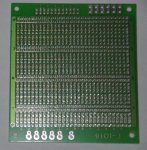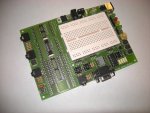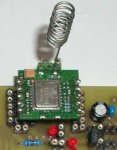Nice idea. A nice development board is a good step.
I haven't looked at what's on offer, so I'm probably going to suggest something already done. So with that in mind, may I tentatively suggest:-
1. A small patch area as discussed above. I'm not too keen on too much patch area where components may be in and out esp if the board is a pth. PTH desoldering can be a bitch!
2. A connector so that most of the connections can be taken out to breadboard.
3. Two isolated regulators so that patch and/or breadboard can be powered separately.
4. Any MAX232 or transistor interface (easier) for PC has jumpered selection to give user a choice of PICAXE pins.
5. A few LEDs DIL Switched to enable/disable.
6. A few push-buttons with jumpered selection of ground/V+ selection.
7. A position for a pot for ADC.
8. Holes big enough so that a crystal can be socketed.
9. SIL res network on PICAXE ports with a jumper so that they can be held high or low.
10. A SIL socket for a character LCD connection plus contrast pot.
11. Maybe holes on the power in(s) lines so that some form of fuse can be included or linked out?
(Extra Luxury: Make it compatible with a few PICAXEs)
If it's a kit then people can choose which components they want to leave out. The board costs for an extra square inch or so would be trivial.
I would need to be convinced about making a small board like this
modular as the space-waste and connectors required would pobably outweigh any cost savings.
Sorry, got a bit carried away there. I was staring at an EasydsPIC4 board whilst typing

PS:- And if the board was going to have regular screwing/uncrewing PCB terminal blocks may I seriously recommend the use of Camden style rising-clamp connectors. Far higher quality than those screwy bent metal things which sometimes need a poke up the hole so you can get a wire in.
But, sorry, they will cost an extra tuppence. Oh Goodness I swore.... and extra tuppence... Gosh maybe an extra 5 pence compared to Ebaygum.




